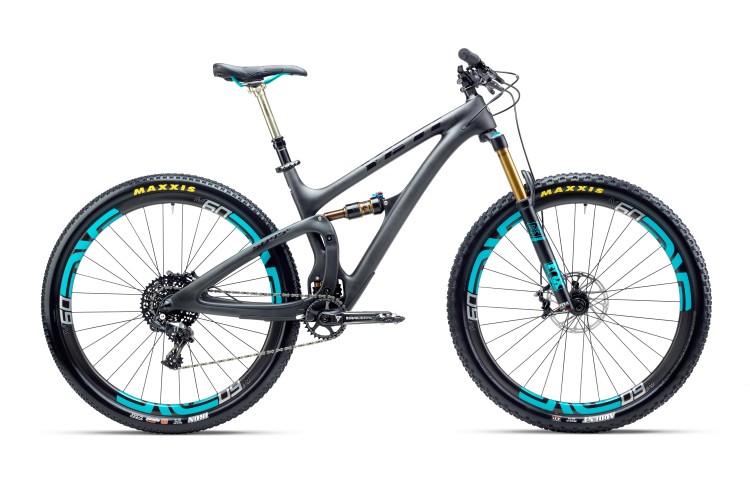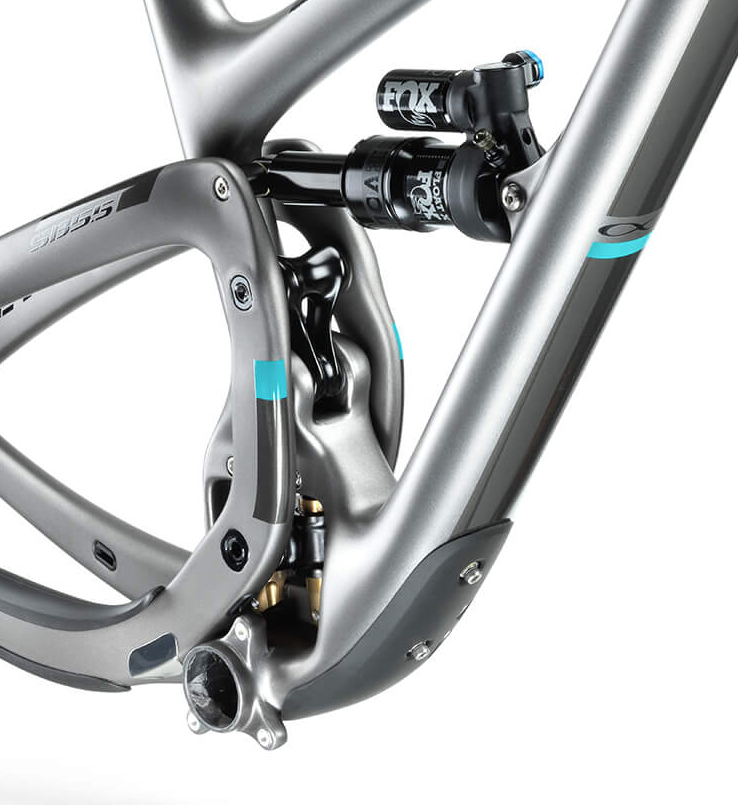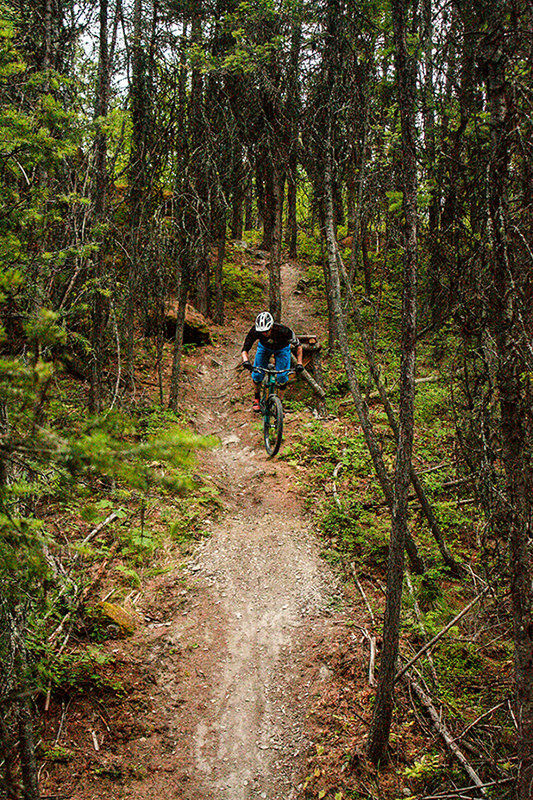2016 Yeti SB5.5
Size Tested: Medium
Geometry: (Here)
Build Overview:
- Drivetrain: Stram X01
- Brakes: SRAM Guide RSC
- Fork: Fox 36 Factory FIT4
- Rear Shock: Fox Float X Factory
- Wheels: DT Swiss 350 / XM481
Wheels: 29′′
Travel: 140 mm rear / 160 mm front
Blister’s Measured Weight: 28.4 lbs (12.9kg) without pedals
Reviewer: 5’9”, 155 lbs.
Test Location: Montana, British Columbia
Duration of Test: About 2 months
MSRP: $6,999.00

The Yeti SB5.5, released last spring to much internet bed wetting, is Yeti’s longest travel 29er. The only longer travel bike in Yeti’s current lineup is the SB6 (which runs on 27.5” wheels).
It’s been a while since I’ve spent much time on a Yeti, and this was my first opportunity to ride one of the latest SB bikes that have Yeti’s new Switch Infinity suspension design. And I’ll admit to being slightly skeptical about the new design, as I often am about linkages that are new and different. But maybe more than any other bike brand, Yeti has a loyal cadre of followers, and the brand has a long history of winning races that doesn’t appear to be letting up any time soon. So maybe all these people know something I don’t, and maybe my skepticism is unfounded.
I’ve spent the last two months or so on the SB5.5, and I’ve arrived at a tentative conclusion. I think this is the fastest bike I’ve been on to date.
Frame
The SB5.5 is only available with a carbon frame, and Yeti has recently released their 2017 lineup which sees the SB5.5 come in two flavors – “Carbon” and “Turq.” The new Carbon version is essentially the same as the 2016 model that I rode, while the “Turq” version uses a higher end, lighter weight carbon layup (but geometry and frame details are the same).
The heart of the SB5.5, along with all of Yeti’s full suspension bikes, is their Switch Infinity system. It looks kind of complicated, but in reality it’s fairly straight forward.

In terms of the basic suspension layout, I like to think of the Switch Infinity system as a modified single pivot. Those little sliders allow the main pivot to move up and down a little bit (they only move about 1.5 cm’s through the entire arc of the travel), which in turn allows Yeti to place a swing link near the shock.
That swing link is key, and does a couple things. First, it substantially stiffens up the rear end – rather than all of the forces being focused on the main pivot, they’re spread between the main pivot and the swing link. Second, the swing link allows Yeti to dictate the suspension kinematics much more precisely – the leverage rate and anti-squat curve, both of which have a big impact on how the suspension moves, can be dialed in by adjusting the size and position of that swing link and its relation to the Switch Infinity sliders.

All that suspension is running on high quality pivots – a collet system helps keep everything snug, and the SB5.5 has nice, custom hardware. In my time on the bike, all the pivots stayed tight and everything is still spinning smoothly.
Cable routing is internal, running through small rubberized ports to help keep the elements out. There isn’t any internal piping in the frame, so running cables on the SB5.5 is a frustrating exercise that requires magnets, swearing, and strong temptations to cut larger holes into your expensive frame. Yeti’s new SB5 frame incorporates a larger port to make this task easier, so hopefully Yeti will incorporate something similar on the SB5.5 in the future.
The rear axle is from Shimano – nothing exotic, but it works well and it’s reasonably low profile. The drive side dropout and derailleur hanger are a single aluminum piece that’s replaceable in case you crunch a derailleur or bung up the axle threads.
The frame gets a small rubberized guard on the downtube as well as some protection on the chainstay. Again, nothing too crazy, but it gets the job done and looks cleaner than most integrated guards I’ve seen.
My biggest gripe about the frame is the lack of a good water bottle mount. There’s one mount on the underside of the downtube which is better than nothing, but it’s a crappy place for a water bottle. And I mean that in a literal sense, since I occasionally end up with horse droppings on my bottle.
NEXT: The Build, Fit and Geometry, Etc.

Thanks for calling out and articulating the seat tube angle issue, which as you mention is one of the most important factors for climbing on a long travel bike. We have reach and stack to accurately define hand and front wheel position but “effective seat angle” is a shot in the dark that’s interpreted differently by each manufacturer. Hopefully some will start to listen.
Cheers
BW
This is a huge problem for taller riders. Many bikes just don’t work for them on climbs because they have too slack seat tube angles paired with short chainstays. When the seat tube is fully extended, for optimal climbing condition, weight balance gets all wrong. Bikes with a big kink in the seat tube, very slack real STA, have real world ESTAs much slacker then claimed. I seriously doubt that 2017 29er Trek Slash works for taller guys. On climbs that is.
Speaking of Evil. They actually changed their official reported ESTA on The Insurgent from the bikes inception, making them slacker. If you bother to calculate you will see that their geometry numbers don’t add up.
Of note, my Santa Cruz Hightower setup with a 160 36 on the front and Float X2 rear has numbers almost identical to the Yeti 5.5, although slightly shorter chainstays. I’ve found very much the same thing coming off my previous Nomad 3, all my Strava DH times in Western Canada terrain have come down without trying as hard.
Those of us that have tried the longer travel 29ers in my crew really think we’ll see more and more in this Enduro segment as the speed advantage seems to be a reality for most people. Interesting also to follow along on EWS setups on the few teams that have equivalent choices in 27 and 29 and ultimately what they choose. Except for Rude boy, most seem to be going the 29 route.
Hey, nice review!
Any thoughts on the comparison between this bike and the Following? Particularly with respect to running the Following with a 140mm fork. Guessing this would have the edge on the really chunky stuff (consecutive hits), I have a Following and notice it can get a little overwhelmed at the back (no surprise though).
Any thoughts appreciated
Hey Dan,
You’re correct that the SB5.5 has the edge on rough terrain, largely due to having a bit more travel. And the addition of a 160mm Fox 36 on the front of the 5.5 can’t be overlooked – it’s not just more travel, but a stiffer, burlier fork, which means you can really get away with pointing it straight into some terrible line choices.
But maybe more than anything, the Yeti just rides quite a bit differently than the Evil. I found the Yeti was happiest staying on the ground and motoring through things, whereas the Evil was a good bit more poppy and playful, and worked better when pumping every little roller on the trail. The Evil has a pretty progressive suspension, which keeps it supple off the top, and makes it a little easier to really load the back end up. The Yeti is much more linear, which means it uses all of its travel more easily, and it does a really good job of just swallowing mid sized hits.
Both are fantastic bikes, just different ways to skin the cat.
-Noah
Hey Noah,
I have ridden The Following but not the SB 5.5 and probably can’t prior to a potential purchase. The Hightower is good fun as you said, feels pretty nimble and very playful for 29. I like that the SB5.5 handles the chunk very well, but just how much do you lose in the playful/fun department? What bike would you personally choose as the daily all mountain aggressive trail bike, that can still hang in the bike park here and there? Compare it to a Mach 5.5 or Evil The Calling if you have rode those 27.5?
Hey Jake,
Compared to various 27.5″ wheeled bikes, the 5.5 just feels like a lot more bike. The long wheelbase and bigger wheels add up to a bike that feels a lot less flickable, and quick direction changes require a lot more effort. In some situations, that makes the bike feel cumbersome, in others it makes the bike feel stable; in other words, the bike’s “bigness” is a good thing some of the time. But that’s also not exclusive to the 5.5 – that’s mostly just a longer travel 29″ bike vs. 27.5″ bike thing.
As far as what I’d personally choose, that’s a tough question. I’ve been on a Hightower for the last 2 months (review coming shortly), and the Hightower feels like a bit less bike than the 5.5. Which is nice on big climbs, and more “trail” oriented rides, but I was faster on the descents on the 5.5. The 5.5 isn’t entirely unplayful, but the Hightower does better at popping and gapping between little trail features. And then bikes like the Following, Smuggler, Django 29, etc. are all fantastic, but they definitely feel smaller. Which is obviously a good thing in situations where a smaller bike is favorable, but they’re also a lot less inclined to go plowing through brake bumped chunder in a bike park situation.
So I guess the short answer to that question is that all of the bikes in this conversation have their merits, and it’s just a question of where you’d rather make some trade offs. But to narrow this down a bit, and operating on the assumption that a long-ish travel bike (130ish mm to 150ish mm) is the best choice for the trails you’re riding, I’d probably look at it like this: if playfulness and flickability are top priorities, I’d be looking at something with 27.5″ wheels. But assuming we’re mostly talking about 29ers, if efficiency is a priority, I’d look at a Hightower. If speed while retaining decent trail riding manners is the priority, I’d go 5.5. I’d probably put an Enduro 29 one notch above the 5.5, meaning it’s more about straight line speed, and sacrifices some trail manners. For unbridled DH plundering, I’d look at a Wreckoning. The new Rocky Mtn. Instinct looks interesting, but all I’ve seen are specs and pictures, so it’s too early to tell there.
Hopefully something in this semi-rambling response is helpful!